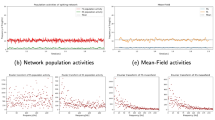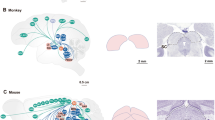Abstract
We recorded from the spiking sustaining unit in the optic chiasm between lamina and medulla in the brain of the blowfly Calliphora vicina, and investigated both temporal and spatial properties of the light-adapted cell. The sustaining unit fails to follow the highest temporal frequencies followed by the photoreceptor, but its temporal resolution is substantially better than that of the on-off unit. The sustaining unit does not display the fast temporal adaptation as previously described in the on-off unit. As compared with the on-off unit, the sustaining unit has a high sensitivity to small contrasts. Although the sustaining unit continues spiking as long as the light is on, its response is also transient as it adapts rapidly after a change of intensity. The receptive field and the line spread function of the sustaining unit have a similar size and profile: a central lobe with a half-width of approximately 2° surrounded by a circular inhibitory zone located at about 3° off-axis.
Similar content being viewed by others
References
Arnett DW (1971) Receptive field organization of units in the first optic ganglion of Diptera. Science 173:929–931
Arnett DW (1972) Spatial and temporal integration properties of units in first optic ganglion of dipterans. J Neurophysiol 35:429–444
Hardie RC, Weckström M (1990) Three classes of potassium channels in large monopolar cells of the blowfly Calliphora vicina. J Comp Physiol A 167:723–736
Hateren JH van (1984) Waveguide theory applied to optically measured angular sensitivities of fly photoreceptors. J Comp Physiol A 154:761–771
Hateren JH van (1992a) Theoretical predictions of spatiotemporal receptive fields of fly LMCs, and experimental validation. JComp Physiol A 171:157–170
Hateren JH van (1992b) Real and optimal neural images in early vision. Nature 360:68–70
Hateren JH van, Laughlin SB (1990) Membrane parameters, signal transmission, and the design of a graded potential neuron. JComp Physiol A 166:437–448
Jansonius NM (1990) Properties of the sodium pump in the blowfly photoreceptor cell. J Comp Physiol A 167:461–467
Jansonius NM, Hateren JH van (1991) Fast temporal adaptation of on-off units in the first optic chiasm of the blowfly. J Comp Physiol A 168:631–637
Jansonius NM, Hateren JH van (1993) On-off units in the first optic chiasm of the blowfly. II. Spatial properties. J Comp Physiol A 172:467–471
Järvilehto M, Zettler F (1973) Electrophysiological-histological studies on some functional properties of visual cells and second order neurons of an insect retina. Z Zellforsch 136:291–306
Laughlin SB (1981) Neural principles in the peripheral visual systems of invertebrates. In: Autrum H (ed) Handbook of sensory physiology VII/6B. Springer, Berlin Heidelberg New York, pp 133–280
Laughlin SB (1984) The role of parallel channels in early visual processing by the arthropod compound eye. In: Ali MA (ed) Photoreception and vision in invertebrates. Plenum, New York London, pp 457–481
Laughlin SB, Hardie RC (1978) Common strategies for light adaptation in the peripheral visual systems of fly and dragonfly.J Comp Physiol 128:319–340
Laughlin SB, Osorio D (1989) Mechanisms for neural signal enhancement in the blowfly compound eye. J Exp Biol 144:113–146
McCann GD, Arnett DW (1972) Spectral and polarization sensitivity of the dipteran visual system. J Gen Physiol 59:534–558
Meinertzhagen IA, O'Neil SD (1991) Synaptic organization of columnar elements in the lamina of the wild type in Drosophila melanogaster. J Comp Neurol 305:232–263
Nässei DR (1991) Neurotransmitters and neuromodulators in the insect visual system. Prog Neurobiol 37:179–254
Shaw SR (1981) Anatomy and physiology of identified non-spiking cells in the photoreceptor-lamina complex of the compound eye of insects, especially Diptera. In: Roberts A, Bush BMH (eds) Neurons without impulses. Cambridge University Press, Cambridge, pp 61–116
Shaw SR (1984) Early visual processing in insects. J Exp Biol 112:225–251
Smakman JGJ, Hateren JH van, Stavenga DG (1984) Angular sensitivity of blowfly photoreceptors: intracellular measure-ments and wave-optical predictions. J Comp Physiol A 155:239–247
Srinivasan MV, Bernard GD (1975) The effect of motion on visual acuity of the compound eye: a theoretical analysis. Vision Res 15:515–525
Straka H, Ammermüller J (1991) Temporal resolving power of blowfly visual system: effects of decamethonium and hyperpolarization on responses of laminar monopolar neurons. J Comp Physiol A 168:129–139
Author information
Authors and Affiliations
Rights and permissions
About this article
Cite this article
Jansonius, N.M., van Hateren, J.H. On spiking units in the first optic chiasm of the blowfly. J Comp Physiol A 173, 187–192 (1993). https://doi.org/10.1007/BF00192977
Accepted:
Issue Date:
DOI: https://doi.org/10.1007/BF00192977




